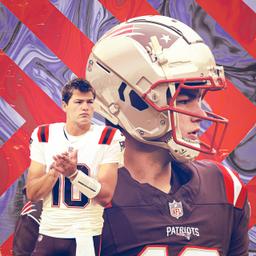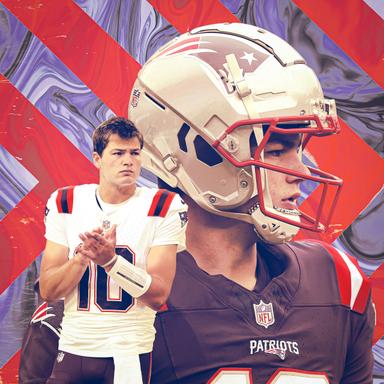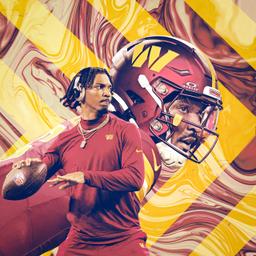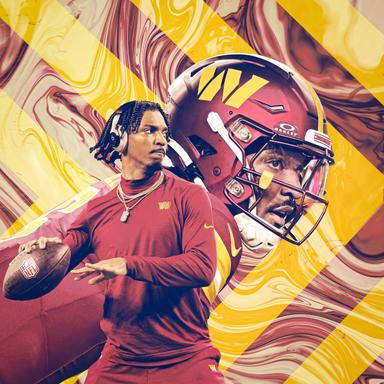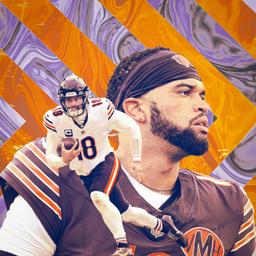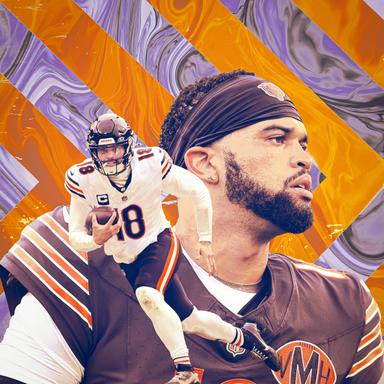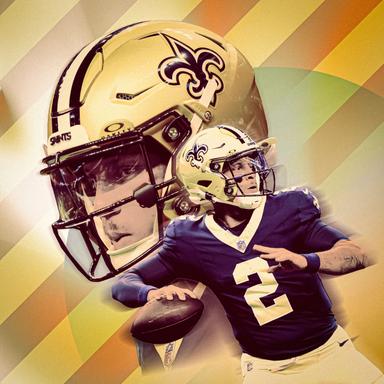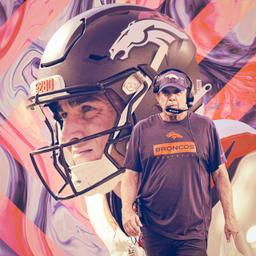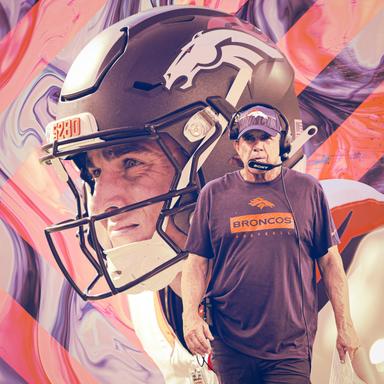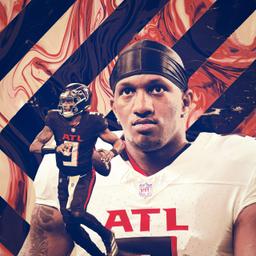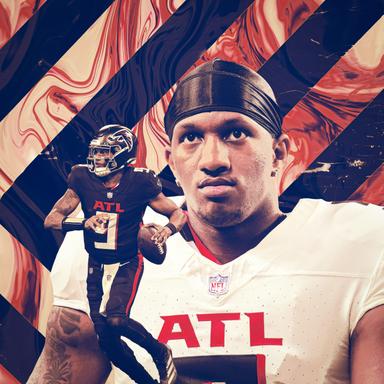The NFL’s 2024 quarterback draft class was historic, with six passers taken within the first 12 picks. Three of those quarterbacks—Caleb Williams, Jayden Daniels, and Bo Nix—were day-one starters for their teams. J.J. McCarthy might have joined that group, too, if not for a preseason meniscus tear that ended his rookie campaign before it started. Drake Maye and Michael Penix Jr. began their careers on the bench but eventually wrestled starting jobs away from veteran teammates. In 2025, all six started their teams’ openers, and that doesn’t include fifth-round pick Spencer Rattler, who won the Saints job in training camp.
It was a big quarterback class, and also an impactful one. Daniels and Nix led their teams to the playoffs last season, and the former brought Washington to within a game of the Super Bowl. Williams is starting to live up to the generational hype in his second year and his first under coach Ben Johnson. Through the first six weeks of the 2025 season, Maye looks like a superstar and might be one big game away from joining the MVP conversation—if he’s not already there.
This class is already starting to take over the league. They’re manning nearly a fourth of the NFL’s starting quarterback jobs, and all but McCarthy seem to have them locked down for the foreseeable future. So prepare yourself now: We’ll be debating and relitigating this group for the next decade-plus. It’s never too early to start, so let’s get into a good old-fashioned redraft.
For transparency, here’s how I stacked the seven quarterbacks before the 2024 draft and the point in the draft where I would have taken them:
- Caleb Williams (top five)
- Drake Maye (top five)
- Jayden Daniels (top 10)
- Spencer Rattler (late first round)
- J.J. McCarthy (early second round)
- Michael Penix Jr. (late second round)
- Bo Nix (late second round)
I’ll be making picks in the redraft based on a mix of what I personally would do, what I think the teams would do with the information available to them now, and the long-term prospects of the quarterbacks—not solely based on who’s currently the better player.
With that out of the way, let’s (re)draft some quarterbacks.
First Pick, to the Chicago Bears: Drake Maye
Actual Pick: Third, to the New England Patriots
Forget about a 2024 redraft. If NFL teams held a draft of every starting quarterback right now, there’s a chance that Maye could go as high as sixth. Patrick Mahomes, Josh Allen, and Lamar Jackson would go off the board first. I’d imagine that Justin Herbert would go fourth, just ahead of Joe Burrow, based on the latter’s durability alone. The top five is firmly established, even if the order of those quarterbacks would be up for debate. But Maye has a strong case after that. He’s not only the most talented quarterback under the age of 25 but also the most well-rounded, the most polished, and, during this season, the most productive.
It’s shocking that Maye has gotten to this point this quickly based on his predraft scouting report. He checked all of the boxes you’d want from a first-round prospect, but he also supposedly had plenty that he needed to work on. Lower-body mechanics were at the top of the list. Poor footwork should have led to inconsistent accuracy, but we haven’t seen that through the first 16 starts of his career. So far this season, only Jared Goff has a higher completion percentage than Maye, only Sam Darnold has a better completion percentage over expectation, and only those two quarterbacks have a lower uncatchable pass rate, per Pro Football Focus. Again, this was supposed to be the flaw in Maye’s game.
Maye’s also been good in all the areas where he was expected to be good. The creative playmaking we saw at UNC has translated to the next level. Maye isn’t just crafting big plays out of structure; he’s also salvaging broken plays by scrambling or dumping the ball off in time to avoid a sack. His pocket movement is advanced for his age, he throws downfield with anticipation, and there’s no lag when he progresses through his reads. Before the 2024 draft, Maye was widely viewed as a polarizing prospect who would require a ton of work. A year and a half later, it’s difficult to find fault in his game. The same cannot be said for the rest of this class—or any of the league’s young quarterbacks.
Williams is starting to find his way in Chicago, but if the Bears got another chance to make the no. 1 pick, they shouldn’t hesitate to take Maye.
Second Pick, to the Washington Commanders: Jayden Daniels
Actual Pick: Second, to the Washington Commanders
Daniels is a special football player. I’m just not sure that he’s a special passer. He has a good arm, but he lacks the high-end arm talent we see in all of the league’s top quarterbacks—save for Burrow, who makes up for that with unmatched accuracy and football intelligence. That’s most evident when Daniels attacks the intermediate and deep areas of the field from a tight pocket. Despite his unreal mobility, Daniels isn’t the strongest off-platform thrower. He’s more likely to skip the ball at his receiver’s feet than to pin it on his chest when he can’t get a clean throw off. And on throws that require more zip, his accuracy can be an issue. Daniels is more of a finesse thrower than a power pitcher, which is fine. But these days, all of the top quarterbacks can do both. We’ve seen other quarterbacks improve their arm strength over their careers—Tom Brady, most notably—but it’s not something that happens often.
That’s one of my hang-ups with Daniels, but it’s largely mitigated by his running ability. He rarely has to throw off his back foot or from a muddied pocket because he scares the daylights out of opposing pass rushes. Defenses are just looking to contain Daniels in the pocket, so they’ll often slow their rush at him rather than trying to cave in the pass protection. Still, opponents have a hard time keeping Daniels in the pocket because he doesn’t need much time or space to escape. He’s just so damn fast and slippery. Unless he slows down or his team starts fielding regular citizens as offensive linemen, pass protection will never be a real issue for him. That’s a valuable trait that would make Daniels worthy of a top pick in any draft class.
But scrambling can be a tricky thing to project in the long term, especially for a quarterback who has a slender frame and has already picked up a few injuries as a runner, including a rib injury last season and a knee injury early this year. After Daniels’s very first pro game, Commanders head coach Dan Quinn seemed worried about how often the QB was scrambling. “For him, create it when it's there, when you can get outside the pocket,” Quinn said after a Week 1 loss in Tampa last season. “We'd love to see him remain a passer first, and I think it's going to come with more experience, honestly.”
Maybe Daniels will eventually make that adjustment, but it hasn’t happened yet. Only rookie Jaxson Dart has a higher scramble rate since the start of 2024, and only Dart has a lower throw percentage on dropbacks that move outside the pocket, per TruMedia. Just 41 percent of Daniels’s trips outside the pocket have ended with pass attempts—the league average is 69 percent. And while Daniels is undoubtedly an effective scrambler, defenses have been doing a better job of keeping their eyes on him after he vacates the pocket. Only 28 percent of his 21 scrambles this season have resulted in a first down. If defenses are going to rally to tackle Daniels as soon as he breaks the pocket, he’ll need to start throwing downfield more often to punish them.
Daniels has the accuracy and feel to do that. And if and when he’s able to get there, defending him will feel like an impossible task for many of the same reasons that Lamar Jackson is so difficult to game-plan against. There’s only so much that you can do against a quarterback who threatens every blade of grass on the field. Even in the early stages of his development, Daniels is hard to stop, as his stats show.
Third Pick, to the New England Patriots: Caleb Williams
Actual Pick: First, to the Chicago Bears
Williams would have been the second pick in this redraft if it were just up to me, but given everything Daniels did to revitalize Washington last season, it’s hard to imagine the Commanders changing course if given a do-over.
Williams is already a good quarterback, but there is plenty of room for growth. He’s got the most talented arm in this class, and he can use it to fire a laser into the tightest of windows or to layer a pass over the second level of the defense. But he’s just as likely to sail a pass over an open receiver’s head, which is a problem that has persisted into his second season. Williams leads the NFL with 59 overthrown passes since the start of 2024, which is 14 overthrows clear of Bo Nix in second place, per TruMedia. His accuracy has improved some this season, but he’s still posting bottom-of-the-league numbers in the category, ranking last in off-target throw rate and completion percentage over expected.
It’s difficult to overlook these accuracy concerns, but that really is the only flaw in Williams’s game. And if his improvement in this area continues at its current pace, he’s got a chance to be as good as any quarterback. The 23-year-old’s game has been mischaracterized based on preconceived notions of how he played in college. Sure, Williams holds on to the ball longer than most quarterbacks, but he’s taking sacks on only 5.9 percent of his dropbacks this season. That ranks 15th. His pressure-to-sack rate (17.9 percent) ranks 16th, ahead of guys like Herbert, Allen, and Jackson. He also ranks well ahead of Maye (29th) and Daniels (28th) in the metric, per TruMedia.
Taking sacks was a significant problem for Williams last season, but he needed just a year—and a head coaching change—to improve. Williams is also far better in the pocket than he gets credit for. He’s dedicated to getting through his progressions and doing so before entering creation mode. His downfield accuracy is an issue, but Williams can be precise on quick throws, which has helped keep Chicago’s offense on track despite the run game’s slow start. The quarterback you see on tape looks nothing like the one people describe when criticizing his game.
10th Pick, to the Minnesota Vikings: Spencer Rattler
Actual Pick: 150th, to the New Orleans Saints
This is a massive jump for a player who was taken in the fifth round just 18 months ago, but it’s worth remembering that Rattler was once viewed as one of the top quarterback prospects in the country before he was benched for Williams at Oklahoma. Talent was never the issue, though, as we’re now seeing in New Orleans, where Rattler appears to have locked down the starting quarterback job and is showing flashes of being a franchise quarterback.
Based on his South Carolina tape alone, Rattler had no business being a day-three pick, which he has proved in his short time as the Saints starter. I blame LeBron James. OK, so it's not LeBron’s fault directly, but the portrayal of Rattler in the LeBron-produced documentary on high school quarterback prospects may have contributed to him dropping to the fifth round of the 2024 draft. Rattler was kind of a dick to his teammates in the doc, which rubbed NFL evaluators the wrong way even years later, as Ian Rapoport reported on draft night.
Listen, if The Ringer were reviewing tape of how I acted in high school, I probably wouldn’t have this job, so who am I to judge? We were all assholes as teenagers, but prospective employers can’t binge-watch our antics on Netflix.
If talent evaluators could have looked past that, they might have fallen in love with Rattler’s game. Even when he was in college, you could see that he had a talented arm, mature pocket presence, and an underrated feel for the game. The guy has had a personal quarterback trainer since the age of 10, and it shows based on how polished he is for a second-year pro who was seen as a late-round prospect.
Rattler doesn’t do anything at an elite level—which can be said of all the quarterbacks below him in this redraft—but there aren’t any obvious weaknesses in his game now that he’s found more consistency with his accuracy and isn’t throwing into coverage nearly as often. We’ve seen him take legitimate steps as a passer over the past year. And while he’s always shown flashes of high-level play—which was on full display in Sunday’s loss to New England, in which Rattler matched Maye throw for throw—Rattler has also raised his floor.
My comp for Rattler at this point would be Darnold. He’s not quite as talented a thrower as Darnold, but the rest of his game matches. We’ve seen how Darnold thrived in Kevin O’Connell’s system last season. And Rattler, with his downfield throwing ability, would be an ideal fit in Minnesota. If the Vikings had the foresight to take a chance on Rattler, O’Connell wouldn’t be talking himself into starting Carson Wentz right now, I can tell you that much.
12th Pick, to the Denver Broncos: Bo Nix
Actual Pick: 12th, to the Denver Broncos
Sean Payton still gets his guy at 12. I wish that I could see what Payton sees in Nix, but I’m struggling to find it on tape. What I do see is a quarterback with good (not great) mobility and a good (but not great) arm. You can build a competent offense around that, provided you have a top offensive line and one of the best play callers in NFL history pulling the strings. But as we’ve seen with Denver’s offense, there’s a limit to how good a unit can be with a quarterback who isn’t comfortable in the pocket, doesn’t play with feel, and cuts corners in his progressions. Nix had a ton of college experience coming out of Oregon and is already 26, but just based on his tape alone, he looks like one of the rawest quarterbacks in this class. A year and change working under Payton hasn’t done much to change that.
Through the first two dozen games of Nix’s career, sack avoidance appears to be his superpower. He’s been sacked on a league-low 3.7 percent of his dropbacks since entering the league. That’s a valuable trait for a quarterback—but his numbers are both inflated and a little misleading. Nix has enjoyed some of the best pass protection in the NFL since joining Denver, and he avoids sacks mostly because he can’t resist a checkdown—sometimes at the expense of throwing to an open receiver downfield. Per Pro Football Focus, Nix has thrown 105 checkdowns since the start of 2024. That leads the league, and only Aaron Rodgers (101) is close. But unlike other checkdown artists, Nix isn’t efficient. He’s lost a total of 20.1 EPA on those plays, the worst mark in the league, per TruMedia. So, yes, Nix is avoiding sacks, but he’s doing it in a way that doesn’t necessarily help his offense move the ball.
The same can be said for his scrambling, which is often viewed as another strength of his game. He’s picked up a first down on just 13.3 percent of his scrambles this season, per TruMedia. Only Matthew Stafford, Mac Jones, and Dillon Gabriel rank behind him. Stafford is aging and has a bad back, Jones runs like he’s aging and has a bad back, and Gabriel has barely played.
Based on all of Payton’s praise for Nix this offseason, I assume that the Broncos would still draft him here if they could do it all over again. But Nix looked like a second-round prospect before the 2024 draft, and he’s done little to change that perception so far.
13th Pick, to the Las Vegas Raiders: Michael Penix Jr.
Actual Pick: Eighth, to the Atlanta Falcons
Penix was drafted two decades too late. There was a time when a stationary pocket passer who had a bazooka for an arm would have had every NFL talent evaluator swooning. Even those with scattershot accuracy were consistently being taken at the top of the draft in the early 2000s. There’s a bit more to Penix’s game than that—he plays with good timing and doesn’t lock on to his first read like most young passers—but it was the major selling point for him when he was coming out of Washington. While former Raiders general manager Tom Telesco said this summer that he probably wouldn’t have taken Penix if he’d fallen to Las Vegas at pick no. 13, I’m not buying it. The Raiders desperately needed a quarterback but struck out on all of the first-round prospects. And in the same interview, Telesco admitted that he would have reconsidered if he’d known he’d get only one year on the job. In this redraft, Telesco gets his quarterback … but still probably gets fired.
Penix is a decent quarterback prospect, and if he can learn to layer the ball rather than throwing every pass as hard as he can, he could evolve into more. But he also played a lot of football in his five years in college, and he’s shown no signs of changing his style. Atlanta’s coaching staff was optimistic that Penix would make a leap in his second season, but that hasn’t been the case. He’s not attacking downfield as often as he did as a precocious rookie, and his accuracy is arguably worse. For a quarterback whose ceiling was questioned throughout the predraft process, his lack of progression is an even bigger red flag than it would be for most second-year passers.
35th Pick, to the Atlanta Falcons: J.J. McCarthy
Actual Pick: 10th, to the Minnesota Vikings
If you were a McCarthy skeptic before the 2024 draft, you’re probably feeling pretty good about your evaluation right now. To be fair, the 22-year-old has played only two regular-season games, but in those performances, he’s been bad in all the ways his doubters expected. He’s looked overwhelmed (and undersized) in NFL pockets. He’s had trouble working beyond his second read, which wasn’t something he had to do often at Michigan. His inability to layer throws, rather than throwing every pass on a line, was an offseason talking point that both he and O’Connell mentioned. And now the Vikings coach says that the team has McCarthy working on his lower-body mechanics to help with his accuracy issues. I don’t want to bury the guy before he’s had a chance to play, but this has been a brutal start to his career.
It hasn’t been all bad for McCarthy, though. He’s been the leader he was billed as during his time at Michigan. His teammates love him and rallied around him as he led Minnesota to a comeback win over Chicago in Week 1. But leadership can’t complete a backside dig route throw, and locker room clout doesn’t help you avoid sacks. Until McCarthy can fix his issues with ball placement and cut his sack rate in half, he’ll have a hard time justifying his real-life draft slot.
So far, he has looked more like the day-two project he should have been. In this redraft, I have him going to the Falcons after they passed on a quarterback in the first round and decided to roll with Kirk Cousins as their starter. Backing up Cousins for a few years would have been the ideal way for McCarthy to kick off his development, and I’m sure that there are a few people in Minnesota who would take that setup right about now.
